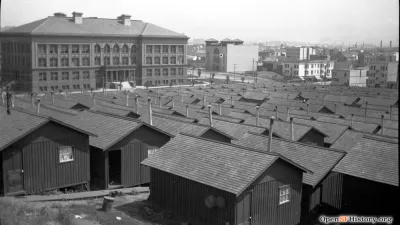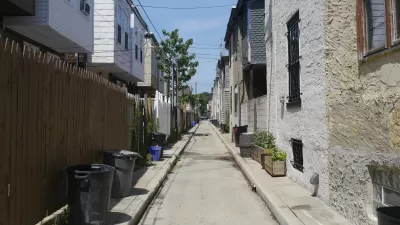As cities such as Chicago and Detroit put forth programs to turn their neglected alleyways into urban amenities, JoAnn Greco speaks with Daniel Toole, a 26-year-old, Seattle-based architect, who has accidentally become an expert on the topic
Toole's emerging expertise was the result of a travel fellowship awarded by his local American Institute of Architects branch, that allowed him to study "this arguably under-appreciated urban form" in Japan and Australia. These studies resulted in a self-published book on Tight Urbanism, an exhibition, and a blog dedicated to the study of alleyways.
Toole is optimistic that as infrastructure such as garbage collection becomes more effective, these underused assets could be appropriated for more social aims, "As waste collection becomes more effective like they've done in some places with a whole underground tube system...Maybe we'll see a proliferation of all this space becoming available. That doesn't mean it has to be turned over to pedestrians and parties, but maybe it could be used as a new kind of green infrastructure, for handling storm water, for growing things. These alleys can be turned into assets for the city. As it stands now, they present a ridiculous amount of space to be used simply for waste conveyance."
"And, of course, they are also an asset for pedestrian passage, they offer exactly the kind of thing that everyone goes to Paris and Rome for: to walk through the little streets."
But Toole needn't have traveled across the world to see examples of urban alleyways transformed into unique amenities. In fact, he needn't have left the west coast, where cities such as Pasadena and San Francisco have created wonderful places out of formerly neglected spaces.
FULL STORY: Why Alleys Deserve More Attention

Alabama: Trump Terminates Settlements for Black Communities Harmed By Raw Sewage
Trump deemed the landmark civil rights agreement “illegal DEI and environmental justice policy.”

Planetizen Federal Action Tracker
A weekly monitor of how Trump’s orders and actions are impacting planners and planning in America.

The 120 Year Old Tiny Home Villages That Sheltered San Francisco’s Earthquake Refugees
More than a century ago, San Francisco mobilized to house thousands of residents displaced by the 1906 earthquake. Could their strategy offer a model for the present?

Opinion: California’s SB 79 Would Improve Housing Affordability and Transit Access
A proposed bill would legalize transit-oriented development statewide.

Record Temperatures Prompt Push for Environmental Justice Bills
Nevada legislators are proposing laws that would mandate heat mitigation measures to protect residents from the impacts of extreme heat.

Downtown Pittsburgh Set to Gain 1,300 New Housing Units
Pittsburgh’s office buildings, many of which date back to the early 20th century, are prime candidates for conversion to housing.
Urban Design for Planners 1: Software Tools
This six-course series explores essential urban design concepts using open source software and equips planners with the tools they need to participate fully in the urban design process.
Planning for Universal Design
Learn the tools for implementing Universal Design in planning regulations.
Clanton & Associates, Inc.
Jessamine County Fiscal Court
Institute for Housing and Urban Development Studies (IHS)
City of Grandview
Harvard GSD Executive Education
Toledo-Lucas County Plan Commissions
Salt Lake City
NYU Wagner Graduate School of Public Service



























